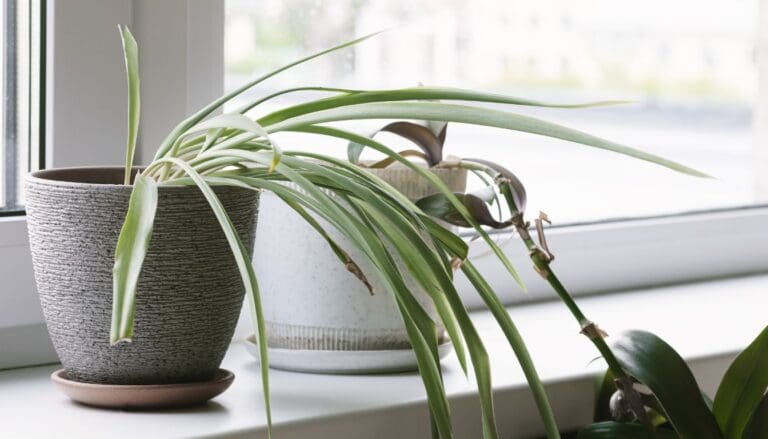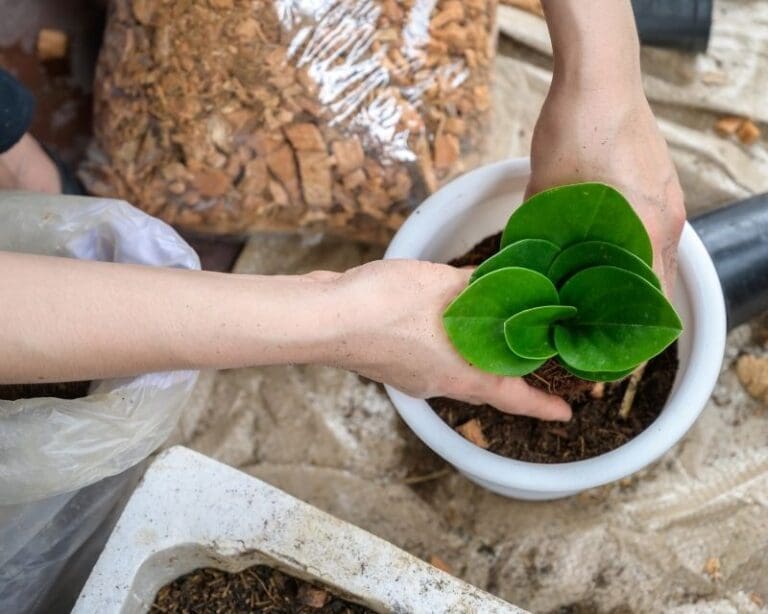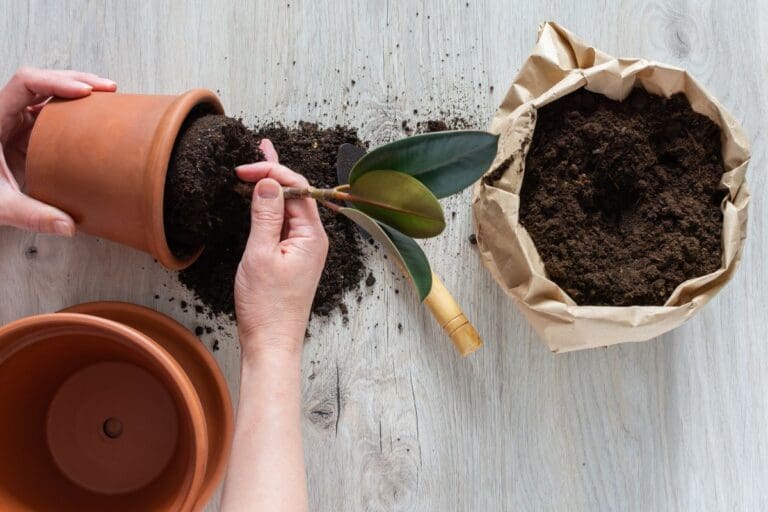Alocasia Growth Rate? (How Big/Tall It Gets+Growing It Faster)
Have you ever wondered how fast an Alocasia(Elephant’s Ears) plant grows and how big it can get? In this blog, we will talk about the growth rate of Alocasia plants and some tips on how to help them grow faster.
Alocasia is a fast-growing tropical plant that can grow 3-5 feet tall in a year when grown outdoors. Potted alocasia can grow up to 1-2 feet yearly as they have a limited space to spread their roots and get less nutrients. You will notice the most growth during the summer months.
The growth speed of the alocasia depends on the variety you own, the external conditions it gets, and the care you provide. If everything is suitable for your alocasia, the plant will grow fast.
In this article, I will explain everything you need to know about the growth of alocasia and how you can make it grow faster.

Please note: Simplify Plants is reader-supported. Some links in the post are affiliate links and I get a commission from purchases made through links in the post.
Factors that affect the growth of alocasia
Many factors are responsible for determining the growth rate of Alocasia plants.
Let’s find out what they are and how they affect the plant.
- Light
- Temperature and humidity
- Season
- The size of the pot
- Soil
- Fertilization
- Watering
- Adaptability
- Pruning
- Pest infestation
Now, let’s dive into the details.
Light
Light is important for all plants and important in determining the growth rate.
Alocasia is a tropical plant that grows under dappled sunlight in its native land.
Therefore, a bright and indirect source of sunlight will be ideal for them.
However, keeping your alocasia in a low-light area will not allow it to grow as fast as it should.
If your alocasia is not getting enough natural light, you can take the help of artificial lights.
You must also remember that alocasia can’t tolerate direct, intense sunlight.
Therefore, if you want your alocasia to grow fast, you should neither expose it to direct sunlight nor keep it in the dark.
Also read: What Kind Of Light Does Alocasia Need? Alocasia Light Requirements
Temperature and humidity

Alocasia belongs to the tropical climate, where it receives warm temperatures and high humidity levels.
Your alocasia will grow fast if you provide a similar environment with suitable temperatures and humidity levels.
However, if the temperature and humidity are unsuitable for the plant, you will notice a slower growth rate.
To ensure that your alocasia gets proper temperatures and humidity levels, keep it away from specific places and make some changes around it if required.
- Avoid placing your alocasia near doors or windows that are opened or closed too frequently.
- Keep the plant in a well-insulated room.
- Don’t place your alocasia near heating sources such as a fireplace, furnace, heater, or radiator.
- Avoid exposing the alocasia to hot or cold drafts.
- Don’t place the plant opposite the AC, as the dry air will reduce the humidity levels around your alocasia.
- Keep your alocasia near a humidifier if you have one, or get a humidifier and place it near the plant to raise the humidity levels.
- Don’t expose your alocasia to low temperatures and frost during winter.
Also read: Should I Mist My Alocasia? (Ideal Humidity+How To Maintain)
Season
Season plays an important role in determining the growth of the Alocasia plant.
The spring and summer seasons are the ideal times for the growth of an Alocasia.
The plant gets the ideal temperatures, light, and humidity levels and grows optimally.
However, the growth of the alocasia will be reduced in winter as it is the dormant period for this plant.
The intensity and duration of the sunlight reduce, and the temperatures and humidity levels decrease in winter.
These are unsuitable for the alocasia, so it goes into a dormant period where it stops growing and saves energy.
It is a natural process that you should not be worried about.
Therefore, noticing slow or no growth in your alocasia during the winter is okay.
However, to help your alocasia survive the winter, you must follow these steps:
- Reduce watering your alocasia in winter as the soil dries out.
- Don’t fertilize your alocasia in winter.
- Avoid placing your alocasia near frosty windows.
- Don’t expose your alocasia to low temperatures and cold drafts.
- If your alocasia is not getting enough light, keep it under artificial lights.
The size of the pot
The pot size can also affect your Alocasia plant’s growth.
If you keep your alocasia in a small pot, it will become root-bound fast, and its growth will be restricted.
Since the roots will not have enough space for growth, they will fail to grow freely.
The roots will grow in a circular motion, displace the soil inside the pot, and not function properly.
The roots will be unable to absorb water or nutrients from the soil so that the plant will lack the energy for growth.
On the other hand, using a pot that is too large can also affect the growth rate.
Keeping your alocasia in a large pot focuses more on root growth and less on foliage growth.
The chances of the alocasia getting overwatered are also higher in a large pot as it contains more soil that holds more water and takes a long time to dry.
So, what is the ideal pot size for an Alocasia?
A pot 1-2 inches larger than the roots of your alocasia is ideal, as the roots will get enough space for growth and proper functioning.
This will help the Alocasia function properly and grow at the optimum level.
Soil
Choosing the right soil mix for your alocasia is important, as the plant will live and grow on this medium.
If you don’t pay attention to the soil requirements or use any soil, it can restrict the plant’s growth and even make it unhealthy.
For example, if you use soil that is too heavy, it will hold excess water and affect the roots, cause root rot, and restrict the growth of your alocasia.
If you use loose soil that drains water too fast, the roots will not be able to absorb enough water and nutrients, so the plant’s growth will slow down.
If you take some time to understand your alocasia’s soil requirements, you can provide the correct soil mix to help it stay healthy and grow.
Let’s take a look at an ideal soil recipe for your Alocasia:
- 1 part orchid bark
- 1 part coco coir
- 1 part perlite
Also read: What Kind Of Soil Does Alocasia Need? (Ideal Soil Mix+Other Requirements)
Fertilization

Potted plants require fertilization because they don’t get nutrients from nature.
When plants grow in the wild, they get nutrients from the soil, but as houseplants, the soil is limited, and so are its nutrients, which get used up and washed away.
Therefore, you must add nutrients to the soil with fertilizers to ensure your alocasia is getting enough.
If you don’t fertilize your alocasia, it will lack nutrients and will not be able to grow properly.
Therefore, you will notice slow growth.
However, too much fertilization will do no good and harm alocasia and its roots.
If you fertilize the plant too frequently or give it too much fertilizer, it will build upon the soil.
These salts will have a harmful chemical reaction on the roots of your alocasia and cause root burn.
This condition will restrict growth and deteriorate the health of the plant.
If you fertilize your alocasia in the winter, it can cause the same problems as the plant doesn’t require fertilization during the dormant period.
If you have overfertilized your alocasia and are not letting it grow, follow these steps:
- Stop fertilizing your alocasia.
- Scrape the soil to get rid of the excess salt.
- Take the plant to the sink and run water over the soil 2-3 times to remove the excess salt from the fertilizer.
- Inspect the roots and prune the damaged ones.
- Repot the alocasia with fresh potting mix.
Also read: What Fertilizer To Use For Alocasia? (Ideal Fertilizer+Dosage Guide)
Watering
Watering houseplants can be tricky for beginners, but a clear understanding is important as it can affect your plant’s growth.
If you use an incorrect watering technique, the plant will undergo different problems.
Giving your Alocasia excess water will make the soil soggy and introduce root rot.
Not giving enough water will dehydrate your alocasia and prevent its growth.
Therefore, you should water your alocasia once in 1-2 weeks, depending on whether the soil is dry or moist.
How do you water the alocasia correctly?
Watering alocasia isn’t easy initially, but you can ace it even as a beginner with the right knowledge.
- Never water your alocasia without checking the soil. You can check the soil with a moisture meter or insert your finger.
- Water the alocasia only when the soil is 25-50% dry.
- If the soil is still wet, you must wait for a few more days before checking it again.
- If you forget to water your alocasia on time, set reminders on your phone or mark your calendar so you know when to check the soil and water your plant.
- Always use well-drained soil and a pot with drainage holes to ensure your alocasia has a proper drainage system.
- An Alocasia living in a plastic pot will require less water than one living in a clay pot.
- Reduce watering by half during winter as the soil dries out.
Also read: How To Water Alocasia Plant? (How Much, How Often & More)
Adaptability
You might notice slow growth after bringing an Alocasia home.
The reason is that a plant takes time to adjust to its new environment, and sometimes it can get stressed due to environmental changes.
If your alocasia is growing slowly or showing unhealthy leaves, give the plant some time and let it adjust to the new environment.
You might notice the same problem when you repot your alocasia or move it from indoors to outdoors suddenly.
Therefore, always make the changes slowly. If your alocasia is stressed after being repotted or brought into a new environment, give it time to recover and provide the ideal conditions.
Pruning

Pruning is an essential part of the care routine of all plants, including alocasia.
Pruning helps you remove the unnecessary parts of the plant that waste its energy and focus it on new growth.
Therefore, you can see that pruning can help your alocasia grow faster.
But without pruning, the plant can become uneven and slow as it will take time to get rid of the damaged leaves naturally.
Keep these in mind while pruning your alocasia.
Keep the following factors in mind while pruning your alocasia to avoid making mistakes.
- Prune your alocasia from the base of the stalk that is damaged or has a damaged leaf.
- Prune with a sharp and sterilized pruner.
- Prune and remove all the overgrown parts, leggy parts, damaged and diseased foliage, and stems.
- The best time to prune your alocasia is during the spring and summer.
- Try not to prune in the winter, as the plant remains dormant during this time.
- Wear gloves while pruning to avoid getting the sap on your skin.
- Water the plant and place it in a spot with bright and indirect sunlight.
Pest infestation
If you notice slow growth on your alocasia, inspect the plant thoroughly, and you might notice some pests.
Pests do no good to your plants and restrict their growth instead.
Most pests feed on the sap of your plants that contain nutrients and water.
So, the plant becomes weak and left with no energy for growth without the sap.
If your alocasia has a pest infestation, there was something wrong with its care routine or the conditions it was exposed to.
Pests such as scales, spider mites, mealybugs, aphids, etc., can attack your alocasia if you follow the wrong watering technique, keep the plant in low light, or don’t provide correct temperatures or humidity.
How to get rid of pests from your alocasia?
Follow these steps if you notice any of these pests on your alocasia.
- Quarantine the plant so other houseplants don’t get a pest infestation.
- Handpick the visible pests from the plant.
- Take the alocasia to the sink and give it a good wash to remove as many pests as possible.
- If you notice any heavily infested areas, prune those with a sharp and sterilized pruner.
- You can use a Neem oil or a horticulture oil and spray it on your alocasia to eliminate the pests.
- You can also get an organic pesticide to treat the pests.
- Place your alocasia under bright indirect light and water the plant when the soil is ready for it.
Also read: How Do I Get Rid Of Bugs In Alocasia? (+Common Bugs Identification)
How do you make alocasia grow faster?

Your alocasia will grow faster with suitable growing conditions and proper care.
Follow these basic care tips if you want your alocasia to grow fast.
| Factor | Correct Care Requirement |
|---|---|
| Light | An Alocasia will require watering once every 1-2 weeks during the growing season. Water the plant after making sure the soil is 25-50% dry. Reduce wearing in winter. |
| Water | Provide warm temperatures between 65-85°F, and don’t let it go below 50°F. |
| Soil | Use well-drained potting soil that also retains the required moisture. |
| Fertilizer | Fertilize your Alocasia with a balanced 20:20:20 NPK liquid fertilizer during the growing months. Stop fertilizing in winter. |
| Temperature | An Alocasia will require watering once every 1-2 weeks during the growing season. Water the plant after ensuring the soil is 25-50% dry. Reduce wearing in winter. |
| Humidity | Fertilize your alocasia with a balanced 20:20:20 NPK liquid fertilizer during the growing months. Stop fertilizing in winter. |
| Repotting | Maintain 50-60% humidity if you want your alocasia to stay healthy and grow. |
| Pruning | Repot your alocasia once in 18-24 months to avoid making it go root-bound. |

Reference: Alocasia sanderiana, Alocasia micholitziana.
Recommended Garden Supplies
| Product Image | Our Recommended Gardening Supplies | Check Offers! |
|---|---|---|
Top Top
Top
Top
Top
Top
Top
Top
Top | rePotme Houseplant and Tropical Classic Potting Soil Mix | Check Offer On Amazon |
 Top
Top
Top
Top
Top
Top
Top
Top | Espoma Organic Indoor Plant Food | Check Offer On Amazon |
 Top
Top
Top
Top
Top
Top
Top
Top | GooingTop LED Grow Light 6000K Full Spectrum Clip Plant Growing Lamp | Check Offer On Amazon |
 Top
Top
Top
Top
Top
Top
Top
Top | Soil Moisture Meter | Check Offer On Amazon |
 Top
Top
Top
Top
Top
Top
Top
Top | Govee Hygrometer Thermometer, Bluetooth Enabled! | Check Offer On Amazon |
 Top
Top | LEVOIT Humidifiers for Large Room(Best For Plants) | Check Offer On Amazon |
 Top
Top
Top
Top
Top
Top
Top
Top | Upgraded DIY Automatic Drip Irrigation Kit, 15 Potted Houseplants Support | Check Offer On Amazon |
 Top
Top
Top
Top
Top
Top
Top
Top | Stainless Steel Heavy Duty Gardening Tool Set | Check Offer On Amazon |
 Top
Top
Top
Top
Top
Top
Top
Top | Bonide Insecticidal Soap | Check Offer On Amazon |
 Top
Top
Top
Top
Top
Top
Top
Top | Bonide 32 oz Spray Neem Oil for Organic Gardening | Check Offer On Amazon |
 Top
Top
Top
Top
Top
Top
Top
Top | Garden Safe Fungicide | Check Offer On Amazon |






